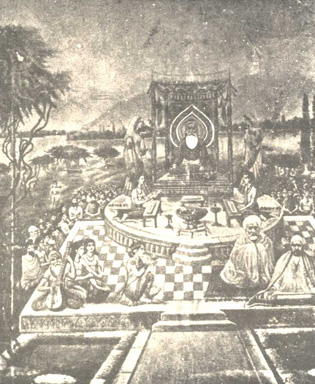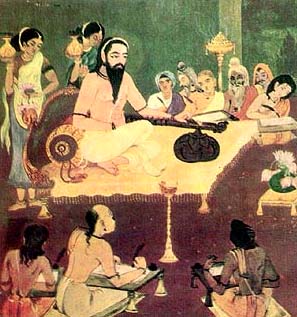Abhinavagupta
- The
Encyclopaedic Scholar
by R. K. Jalali
The present generation of Kashmiris is largely
ignorant of the great luminaries - sages, saints
and mystics - who from time immemorial not only
gave new dimensions to the development of Kashmiri
culture but also developed the cultural heritage
of our homeland. One such luminary was
Abhinavagupta Acharya. An outstanding Indian
philosopher, a great intellectual and a writer on
aesthetic theory, Abhinavagupta was a spiritual
descendant of Somananda, founder of the
Pratyabijnya metaphysics, the
"recognition" school of Kashmiri
Shaivist monism.

Introduction
As
it is beyond the scope of this article to set out
or elucidate the tenets of Kashmir monistic
Shaivism and its great exponents, here only a
brief introduction to the life and works of
Abhinavagupta is given. Kashmir Shaivism was
developed in the light of monism by great thinkers
such as Somananda, Kallata, Utpala, Abhinavagupta
and Khsemraja. Somananda, the author of Sivadristi
who flourished towards the close of the 9th
Century A.D., has been described as the founder of
the Pratyabhijnya system; Utpaladeva, the author
of Isvara Pratyabhijnya Sutras or Karikas, who
lived about 900-950 A.D., is regarded as the
organiser of this system; and Abhinavagupta, the
author of the two commentaries, Laghvi-Vimarsini
and Brahati- Vimarsini and also Tantraloka, is
known as the expounder and commentator of Kashmir
Shaivaism. The later teachers who flourished
between A.D. 1200 and 1800 included Kshemaraja,
Yogaraja, Jayaratha, Sivopadyaya and
Bhaskaracharya.
Ancestors
We
get an authentic, though brief, account of
Abhinavagupta's ancestors, parents, relatives, his
several gurus and his distinguished works from his
own commentaries. In the concluding lines of his
commentary on the Paratrinshika which is a
dialogue between Bhairava (Shiva) and Bhairavi (Shakti)
in 35 Slokas and at the end of Ishwar Pratyabijnya
Vimarsini, Abhinavagupta writes that his remote
ancestor, Attrigupta, lived in Autarvedi and
migrated to Kashmir at the instance of King
Lalitaditya. In the family of Attrigupta was born
Varahagupta. His son was Narsimhagupta, known as
Chukhala (a devotee of Shiva), and father of
Abhinavagupta. His mother's name was Vimla or
Vimalkala. Dr. K.C. Pandey states that being born
of such spiritually high personages, Abhinavagupta
was peculiarly qualified to compose a work
containing a summary of all the Agama works on
Trika- Shastra. He was a born Yogin, a devotee of
Lord Shiva and led a celibate life. Among his
great relatives Abhinavagupta makes a special
mention of his father's maternal grandfather,
Yasoraja, a man of great learning. One significant
statement that he makes is that Yasoraja wrote a
commentary on Paratrinshika for the benefit of his
younger brother Monorathgupta, a Brahmin named
Karna, son of Vallabha, a Minister of King
Yashaskara of Kashmir, and one Ramadeva, who was
proficient in grammar, Tarka and Mimansa.
On
the basis of the facts we gather from his works it
is believed that Abhinavagupta was probably born
about 950 A.D. After having worked indefatigably
for more than 40 years, and having fulfilled the
great mission for which he was born, the tradition
has it that "Abhinavagupta entered the
Bhairava cave in village (Bhiruva), along with his
1200 disciples, and thus departed from this world
never to be seen again."
Voluminous
Writer
In
his distinguished book Abhinavagupta, Dr. Pandey
writes that Abhinavagupta, being a voluminous
writer, has to his credit as many as 41 works.
Among his works the most notable are his two
famous commentaries on IPK, namely Isvara
Pratyabhijnya Vimarsini and Isvara Pratyabhijnya
Vivrti Vimarsini, Malini Vijayvartika Parmarthsara,
Tantrasara, Tantraloka, Paratrimshika Vivrti,
Bhairavastava, Kramastotra, Bodhpanchdashika and
Bhagavadgitartha-Sangraha.
Broadly
speaking, Abhinavagupta's works fall into four
groups. The first group deals with his work on
Tantras. The most voluminous work in this group is
Tantraloka that enumerates the Tantrik Agamas and
dwells upon the Elevated way to freedom and the
three methods of realizing the Ultimate Reality,
known as Sambhavopaya, Saktopaya and Anovapaya.
The other important work belonging to this group
is Malini-Vijaya Vivrti which is supposed to have
been written by him at Pravarpura in the eastern
part of the valley.
The
second group consists of his Strotras such as
Bhairvastava and Kramastotra as well as a few
small treatises like Bodh-Punch Dashika. A third
group includes his works on dramaturgy, poetics,
aesthetics an the rhetoric. He learnt dramaturgy
under the guidance of a great master called Tota
and poetics under Induraja. Prof. P.V. Kane
maintains that in these two branches of learning,
"his two works, i.e. Lochan and Abhinav
Bharati are monuments of learning, critical
insight, literary grace and style."
The
last group constitutes his work on the Pratya
bhijnyasastra, the monistic philosophy of Kashmir
Shaivism. In this group we have his matchless
contributions to this system, the profound and
subtle commentaries on IPK.
Great
Contribution
A
word about Abhinavagupta's great contribution to
Pratybhijnya system. Together with Somananda's
disciple, Utpaladeva, Abhinavagupta is the most
important representative of the school. He
conceived Shiva, the I or Consciousness, and the
All as synonymous and multiplicity or objectivity
as an expression of the freedom and strength of
the 'I' which it affirms and realizes itself
precisely as I, consciousness or freedom. This
concept of freedom (Swatrantya) is one of the
principal achievements of Kashmiri Shaivist
thought. As Abhinavagupta in his introduction to
IPK holds:
<verses>
Pratyabbijnya,
i.e. the recognition of the supreme nature of
self. is prescribed in the system for the service
of man, as a means of attaining all that is of the
highest value. In its essence it unfolds the
glorious possibilities and potentialities of man.
It upholds the sovereignty of the individual and
lays emphasis on recognising (Pratabhijnya) of
self (Atman). The profounder faculty is the really
Real within us. Man is not merely a speck of dust
but an immense force, comprising a comprehensive
consciousness and capable of manifesting through
his mind and body limitless powers of knowledge
and action (Jnana Shakti and Kriya Shakti). This
system of thought alone is the most modern of all,
inasmuch as it is based on sound rational and
scientific principles.
Dr.
R.K. Kaw analyses it thus: "It recognises the
democratic idea of sovereignty of human individual
i.e. superiority and dignity of man, and lays
emphasis on equality and universal brotherhood of
mankind, irrespective of diversity of caste,
creed, colour and nationality."
Pratyabhijnya
has thus shown to mankind a new way (Nava Marga)
to human peace and freedom. This is what
Abhinavagupta taught us 800 years ago. But for his
expositions, this great philosophy of Kashmir
could not have been evaluated in its true
perspective. In fact, it was he who made this
system intelligible, "although his ideas are
mostly embedded in a mass of polemics." This
encyclopaedic scholar is not only regarded as one
of the noblest sons of Kashmir but also one of the
most remarkable personalities of medieval India.
Source:
Koshur
Samachar
| 














No one has commented yet. Be the first!